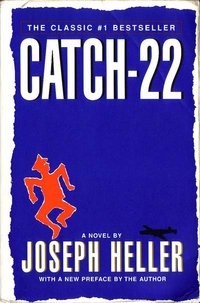Catch-22
|
|
- For other uses of this term, see Catch 22.
Catch-22 is a 1961 novel by American novelist Joseph Heller. Although primarily classified as an anti-war novel, Catch-22 is also a critique of bureaucracy in general. The phrase "catch-22" has come into common use to mean a cyclical conundrum, or "no-win situation" based on its meaning in the book as described below.
The novel follows a fictional World War II US Army Air Corps B-25 bombardier, Captain Yossarian, and a number of other American airmen during World War II, based on the island of Pianosa, west of Italy. (A magazine excerpt from the novel was originally published as "Catch-18", but Heller changed the title after another World War II novel, Leon Uris's Mila 18, was published.) Its pacing is frenetic, its tenor is intellectual, and its humor is largely absurdist -- but with grisly moments of realism interspersed. As the Czech writer Arnošt Lustig (http://www.smallmouthpress.com/authors/lustig.html) recounts in his latest book 13x18 (http://www.radio.cz/pictures/knihy/lustig_portrety.jpg), Joseph Heller personally told him that he would never have written Catch-22 had he not first read The Good Soldier Švejk by Jaroslav Hašek .
The sequel to Catch 22, Closing Time, was published by Joseph Heller in 1994.
| Contents |
"Catch-22" in the novel
Within the book, catch-22 is a military rule, the circular logic of which most notably prevents anyone from avoiding combat missions:
- One may only be excused from flying bombing missions on the grounds of insanity;
- One must assert one's insanity to be excused on this basis;
- One who requests to be excused is presumably in fear for his life. This is taken to be proof of his sanity, and he is therefore obliged to continue flying missions;
- One who is truly insane presumably would not make the request. He therefore would continue flying missions, even though as an insane person he could of course be excused from them simply by asking.
As in the above example, much of Heller's prose in "Catch-22" is circular and repetitive, exemplifying in its form the structure of a catch-22.
Catch-22 is also invoked at other points in the novel to justify various other actions. At one point, victims of harassment by military agents quote the agents as having explained one of Catch-22's most macabre and rococo provisions in this fashion: Catch-22 states that agents enforcing Catch-22 need not prove that Catch-22 actually contains whatever provision the accused violator is accused of violating. An old woman explains: "Catch-22 says they have a right to do anything we can’t stop them from doing." Yossarian comes to realize that Catch-22 doesn't actually exist, but that because the powers that be claim it does and the world believes that it does, it nevertheless has potent effects. The combination of brute force with specious legalistic justification is one of the book's primary motifs.
One of the many strange aspects of this book is that, despite the fact that the (official) villains are the Germans, no German soldiers ever actually appear in the story. As the narrative progresses, Yossarian comes to fear American bureaucrats more than he fears the Germans attempting to shoot down his bomber.
The movie
Catch-22 is also a movie based on Heller's book, released in 1970 with a screenplay by Buck Henry. Along with Henry, the cast included Alan Arkin, Art Garfunkel, Bob Newhart, Anthony Perkins, Paula Prentiss, Jon Voight, Richard Benjamin, and Orson Welles. The film was directed by Mike Nichols. It was not regarded as a great success, earning less money and acclaim than M*A*S*H, another antiwar-themed black comedy from the same year.
The adaptation to film changed the book's plot substantially. Several story arcs are left out, and many characters in the movie speak the dialogue and experience the events of other characters in the book. This significantly alters the implications of some events.
External links
Characters in the book
- Yossarian
- "Aarfy" Aardvark
- Appleby
- Captain Black
- The C.I.D. Investigators
- Colonel Cargill
- Colonel Cathcart
- Clevinger
- Nurse Cramer
- Major Danby
- Doc Daneeka
- Mrs. Daneeka
- Major —— de Coverley
- General Dreedle
- Dreedle's girl
- Dobbs
- Nurse Duckett
- Dunbar
- Dori Duz
- Captain Flume
- A. Fortiori
- Gus & Wes
- Havermeyer
- Huple
- Hungry Joe
- Sergeant Knight
- Corporal Kolodny
- Colonel Korn
- Kraft
- Luciana
- The Maid with the lime-colored panties
- Major Major Major Major
- McWatt
- Michaela
- Milo Minderbinder
- Colonel Moodus
- Mudd (aka the Dead Man in Yossarian's tent)
- Lieutenant Nately
- Nately's Whore
- Nately's Whore's Kid Sister
- The Old Man in Rome
- Orr
- General Peckem
- Piltchard & Wren
- Kid Sampson
- Major Sanderson
- Lieutenant Scheisskopf
- Mrs. Scheisskopf
- Corporal Snark
- Snowden
- Soldier in White
- The Soldier Who Sees Everything Twice (aka Giuseppe)
- Dr. Stubbs
- Chaplain Tappman
- The Texan
- Sergeant Towser
- Corporal Whitcomb
- Chief White Halfoat
- ex-PFC Wintergreen

